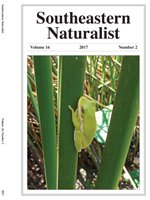Acorns represent a critical pulsed food source for American Black Bears (Ursus americanus) in the southern Appalachians, and represent their primary hibernation reserves. We used 20 years of acorn-mast data collected in northwestern South Carolina and examined time-lagged correlations to American Black Bear population growth rates (lambda), human—bear interactions, and bear visitation to bait stations. Our goal was to assess the relative significance of annual indices monitored for state bear management. Our results indicated that lambda was linked to acorn crop quality, although the correlation varied with oak species: positive with white oaks and negative with red oaks. Human—bear interactions were negatively correlated to mast in the same year. There was no significant relation between bait-station visitation and mast or lambda. Overall our study reflects gaps in current monitoring practices, and we provide ideas towards refining them.
How to translate text using browser tools
1 June 2017
Relationship of Acorn Mast Production to Black Bear Population Growth Rates and Human—Bear Interactions in Northwestern South Carolina
Shefali Azad,
Tammy Wactor,
David Jachowski
ACCESS THE FULL ARTICLE

Southeastern Naturalist
Vol. 16 • No. 2
June 2017
Vol. 16 • No. 2
June 2017




